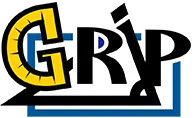
Table of Contents
- GeT: A Pencil Community Flourishes with Recent Updates and Exciting Opportunities by Amanda Brown
- Status of the GeT Volume by Laura Pyzdrowski
- Geometry for the Artist by Catherine A. Gorini
- Member Highlights
- Upcoming Seminars

GeT: A Pencil Community Flourishes with Recent Updates and Exciting Opportunities
by Amanda Brown
Since our last newsletter, there has been a lot of activity taking place within the GeT: A Pencil community. We recently convened for a Community Meeting on September 8, 2023, and many of us had the pleasure of reconnecting at PMENA 2023 in Reno. These gatherings, whether formal meetings or spontaneous encounters at conferences, are cherished opportunities to share insights, collaborate on projects, and engage in stimulating discussions. Notably, they also offer a chance to welcome new colleagues into our thriving community. As we reflect on these events, it is clear that the GeT:A Pencil community is rapidly expanding. In this update, we will delve into the highlights from these recent happenings.
Community Member Updates
Our Community Meeting kicked off with engaging updates from various community members. It was a privilege to hear about recent presentations and research findings related to the ongoing work taking place within GeT: A Pencil. At PMENA, we also noted some community members seizing the chance to share their ongoing GeT Support projects with fellow attendees. If there are any updates we missed or overlooked, we encourage you to reach out; we are eager to learn about and share your contributions across the community. These updates are not only informative but also serve as opportunities for collaboration. They allow individuals to explore possibilities for future presentations building upon prior work.
Here are some noteworthy presentations we learned about:
Steve Cohen from Roosevelt University gave two presentations, both titled “Essential Student Learning Objectives for Geometry for Teachers (GeT) Courses,” in April of 2023. One happened at the Illinois Section of the Mathematical Association of America (ISMAA) annual meeting, and the other happened at the Chicago Symposium Series for Excellence in Teaching Science and Mathematics: Research and Practice.
Stephen Szydlik from University of Wisconsin-Oshkosh also presented about the GeT Student Learning Outcomes (SLOs) in April of 2023. His presentation took place at the Wisconsin Section meeting of the MAA (Mathematical Association of America) at UW-Stout.
Dorin Dumitrascu from Adrian College also presented about the GeT SLOs in March of 2023. His presentation, titled “A Student Learning Outcomes Perspective on the College Geometry Course for Secondary Teachers,” took place at the 2023 Annual Meeting of the MAA-Michigan Section, Alma, Michigan.
Both Steve Cohen and Stephen Szydlik were present at the Community Meeting and provided details about their presentations and ways that the work was well received, providing other instructors not involved in the work with valuable insights that sparked engaging discussions among attendees. They also both expressed a willingness to share about their experiences, including details about their slide decks if anyone is interested in reaching out.
At the PMENA 2023 conference, Steve Boyce from Portland State University and Mike Ion from the University of Michigan shared their research about college students’ mathematical reasoning when engaging with Adinkra, during a poster session. Their presentation offered analysis about student responses to tasks involving student-created symbols and their geometric justifications. We look forward to hearing more about how the presentation was received from participants.
Members of the GRIP LAB at the University of Michigan also shared work at the PMENA 2023 conference, in a talk entitled “How instructors of undergraduate mathematics courses manage tensions related to teaching courses for teachers?”. Their insights into the complexities of teaching the geometry course for secondary teachers resonated with both instructors and researchers.
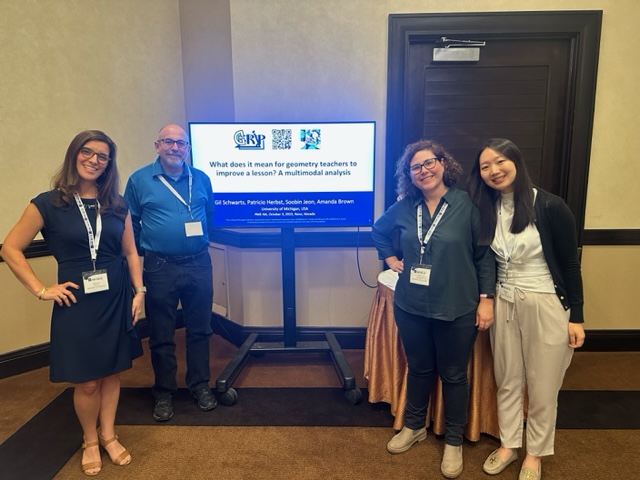
For those who could not attend these talks, rest assured that both presentations will soon be available in the PMENA proceedings. We extend our heartfelt appreciation to all these presenters for their dedication to knowledge sharing within our community.
We want to emphasize that we are always eager to receive updates from the community, whether they pertain to presentations, new publications, or personal or professional accomplishments. In every newsletter, we feature a community member, and we look forward to hearing from you. While our community continues to grow, it remains tightly knit and thrives on celebrating each other’s achievements. So, if you have an update—no matter how big or small—please share it with us by reaching out to the project manager, Inese, inesebp@umich.edu.
Working Group Updates
During the Community Meeting, we had the privilege of hearing updates from various Working Groups, each diligently working on projects related to curriculum development and research. These groups play a pivotal role in our collective mission to use the undergraduate geometry course as a lever for making a positive impact for increasing the capacity for teaching high school geometry. Here are the highlights from their updates:
Julia St. Goar from Merrimack College and Steve Boyce from Portland State University shared how the Transformations Working Group has been going. This group has been actively engaged in creating lessons centered around the symmetries of Adinkra cultural symbols. Currently, they are focusing on implementing lesson study and conducting lesson observations to further enhance their materials. If you are interested in joining their discussions, the group meets every other Wednesday at 2 pm Eastern; the next Transformations meeting will be Wednesday, October 18.
Nat Miller from Northern Colorado University shared how the Teaching GeT Working Group has been going. The Teaching GeT Working Group successfully completed the development of a set of 10 essential Student Learning Objectives (SLOs) for the GeT course. Now, they are exploring their next steps, which may include activities such as observing each other teach GeT courses and developing curricular materials. Everyone is welcome to join their discussions during their Monday meetings at noon Eastern. The next Teaching GeT is Monday, October 23.
Mara Markinson from Teachers’ College at Columbia shared about how the ELSO Working Group is going. The Engaging with SLOs Working Group comprises both high school geometry teachers and university-level instructors. Last year, they reviewed and discussed all ten of the SLOs’ narratives, provided feedback on two of the ten SLOs, and are determined to complete this task by providing feedback on the remaining six SLOs. Their feedback will be instrumental in revising the original drafts of the SLOs. Additionally, the group aims to examine student work from geometry tasks suitable for both secondary and college settings. Meetings are held every other Thursday at 4 pm Eastern. The next ESLO Working Group meeting will be on October 19.
We want to emphasize that all the working groups are open to new members, and we encourage anyone interested in joining to participate in their respective meetings. Your contributions and insights are highly valued as we collectively strive to elevate mathematics education.
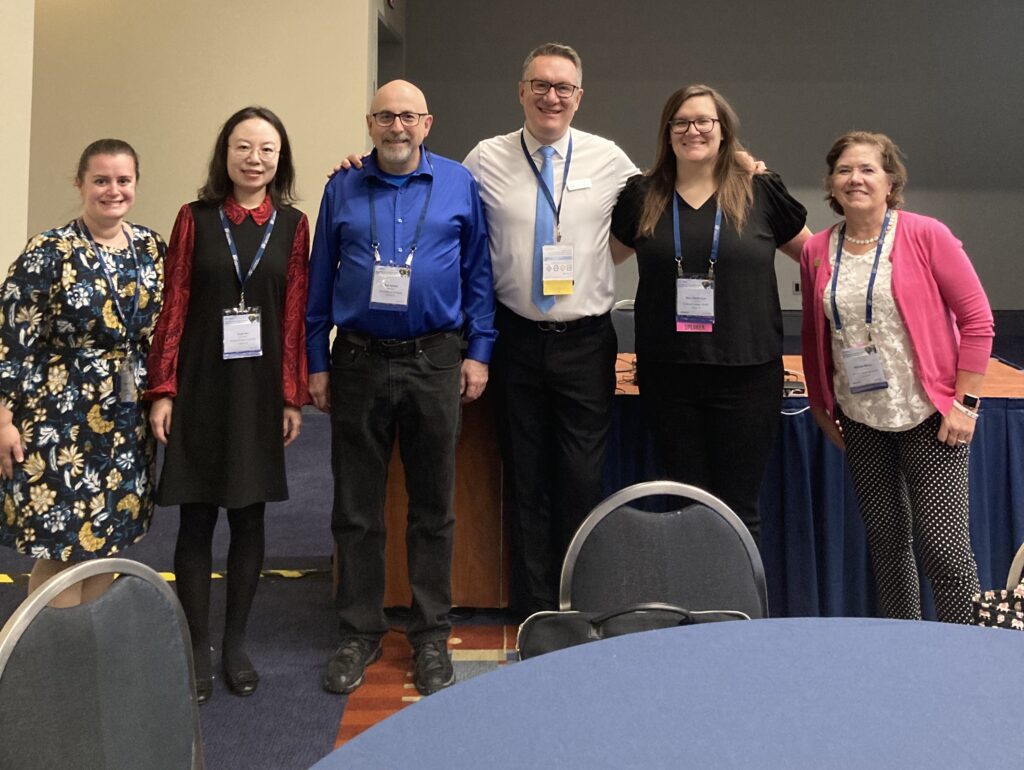
Exciting Opportunities Ahead:
Throughout our community meetings and gatherings, members are consistently highlighting exciting opportunities on the horizon. Our community actively explores avenues to contribute to the field of secondary and undergraduate mathematics education, including potential book projects, research initiatives, collaborative teaching endeavors, and the development of teaching materials. We encourage community participants to get involved and share their expertise. Below are some opportunities that are currently happening or being discussed within the GeT: A Pencil community:
Task Development: With the completion of the first draft of the SLOs, there is a growing interest in mathematical task development that aligns with these objectives. Groups of instructors are considering the identification, development, and cataloging of a repository of tasks to effectively teach and assess the SLOs. The notion of collecting and sharing student work for analysis is also under consideration.
Collaborative Efforts: Our community is characterized by its collaborative spirit, with many members expressing their readiness to share resources, tasks, and research findings. It is a place where people find like-minded collaborators. Several individuals are currently collaborating on chapters for a forthcoming book, and others are joining forces to propose new research projects that emerge from our community’s work. As we move forward, we anticipate even more opportunities for collaboration to emerge and thrive.
Future Community Gatherings: Our Community Meeting concluded with a glimpse of upcoming events and gatherings. We remain steadfast in our commitment to providing opportunities for undergraduate instructors and researchers, as well as high school geometry teachers, to connect, learn, and grow together. These gatherings serve as excellent avenues to stay connected and informed about the latest developments in mathematics education. Although we have the RUME meeting in 2024 and the Spring GeT: A Pencil Community Meeting on the horizon, it is worth noting that our community’s presence is increasingly felt at various conferences. So, wherever you may find yourself, keep an eye out for fellow GeT: A Pencil members; you never know where our community might gather (most recently at an impromptu lunch at PMENA).
In closing, we extend our heartfelt gratitude to the active and engaged members of our community. Your dedication to enhancing mathematics education is a constant source of inspiration, and we eagerly anticipate our next gathering and the unexpected encounters that lie ahead. To our new members, welcome! You have joined a vibrant and supportive community that thrives on collaboration and celebrates its members. I know I speak for the community when I say, we cannot wait to get to know you.
Suggested Citation
Brown, A. (2023, October). GeT: A Pencil Community Flourishes with Recent Updates and Exciting Opportunities. GeT: The News!, 5(1). https://www.gripumich.org/v5-i1-fa2023/#get-a-pencil-community-flourishes-with-recent-updates-and-exciting-opportunities

Status of the GeT Volume
by Laura Pyzdrowski
When asked to write this article, I decided to use a bit of space to share some thoughts about the professional adventure that I have experienced as a member of the GeT community, a community which I find to be welcoming and collegial. Since becoming a member of this community, I have deepened my own content knowledge and have enhanced my teaching skills. My scholarly work has flourished while working with colleagues who have similar interests. I was a bit apprehensive when asked to serve as a co-editor of the GeT volume. However, my experiences working in this community have been so positive that I decided to step into some new territory. One comforting thought as I took that step was that my work would allow me to give back to our community. The amount of time spent on related tasks increases with each phase of this endeavor, but I have learned so much. I continue to appreciate how much effort the GeT team puts into supporting our community to be relevant and of high quality. Next, you find some details about the status of the GeT volume.
It is still our plan to have “The GeT Course: Resources and Objectives for the Geometry Courses for Teachers” completed by the end of May 2024. At that time, the volume will be submitted to the Mathematical Association of America (MAA), which will then conduct its own review. It is envisioned that the book will be useful to anyone interested in the undergraduate geometry courses taken by pre-service teachers. Chapters in this volume will also further advance the development of the Student Learning Objectives (SLOs – see https://getapencil.org/student-learning-objectives/) for the preparation of secondary mathematics teachers. For those of you who are curious about the details regarding submissions, as of this writing, there are 65 submitted chapters with an additional 7 outstanding anticipated submissions. Outstanding submissions are primarily from those invited to write about special topics related to their own particular contributions to the field and from those willing to write additional chapters in order to help evenly distribute the work in the compilation. Current categories of the volume are: Background, Commentary, Activities, Assessment, Community and Scholarship, Course Sequence Conceptualization, and Teaching K12 High School Geometry. At the time of this writing, 27 chapters are still under review. Initial decisions have been sent to 37 corresponding authors. Of those, 21 are expected to have major revisions and 15 to have minor revisions. Authors were given the option of requesting a double- or single-blinded review process. It is envisioned that the reviews, being developmental in nature, will provide sufficient guidance to assist authors to enhance the quality and impact of their contributions. In addition, reviewers are provided with the full decision letter and all reviews when decision letters are sent.
While there is no promise that all contributions will be accepted for publication in the volume, it is the intent that the process being used will help authors improve their work. The process is meant to ensure that submissions are a good fit for the volume by inspiring the implementation of the SLOs into Get Classrooms and by informing conversations about future versions of the SLOs.
As GeT instructors, we live through the demands of jobs that require attention to be distributed among teaching, service, and scholarly work. As part of our scholarly work and service this academic year, members of our community will be busy writing and reviewing GeT chapters. Together, we march on toward the completion of our common vision of the publication of the GeT volume.
Suggested Citation
Pyzdrowski, L. (2023, October). Status of the GeT Volume.GeT: The News!, 5(1). https://www.gripumich.org/v5-i1-fa2023/#status-of-the-get-volume

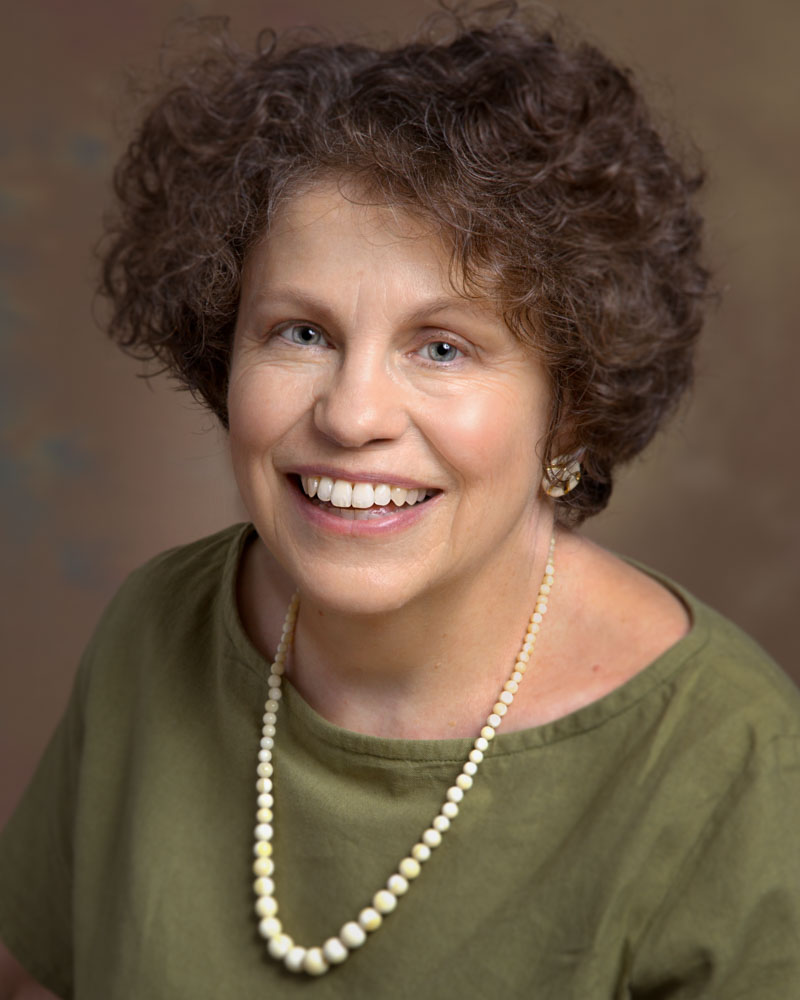
Geometry for the Artist
by Catherine A. Gorini
People often wonder whether artists really use geometry. I am convinced that they use geometry all the time—and that they use every kind of geometry. Sometimes artists have studied geometry; Salvador Dalí learned mathematics from Thomas Banchoff and René Thom. M.C. Escher used ideas from H.S.M. Coxeter and Roger Penrose; Leonardo da Vinci was himself a mathematician. In other cases, it seems like artists get their geometric knowledge and inspiration the same way we mathematicians do; one can imagine ancient artisans developing symmetric designs by trying out different ideas to see what works.
I have recently completed a textbook, Geometry for the Artist (Gorini, 2023), that shows how art can enrich the teaching of geometry. The main topics are symmetry, perspective, fractals, lines and curves, surfaces, Euclidean and non-Euclidean geometry, and topology. In this note, I will share some ways to incorporate art into a geometry course.
Symmetry. We find symmetric designs and patterns everywhere. Artists use symmetry to convey a feeling of balance and orderliness and even, in the case of band ornaments or tilings, the idea of infinity. The mathematics of symmetry explains the structure of designs and patterns and gives artists ways to create new designs and patterns. Interestingly, artists found two-dimensional patterns well before mathematicians could prove their properties. To analyze and create symmetric designs, we use symmetry transformations, which are simply the transformations—rotation, reflection, translation, or glide reflection—that leave a pattern or design unchanged.
There are many ways to use symmetric designs while studying geometric transformations:
- Find the symmetry transformations (by giving rotocenters and mirror lines) of finite designs.
- Find the symmetry transformations (by giving rotocenters, mirror lines, translations, and glide reflections) of band ornaments and tilings.
- Find the symmetry transformations of patterns and designs from a variety of world cultures.
- Find finite designs, band ornaments, and tilings in the environment and describe their symmetry transformations.
- Use dynamic geometry software to re-create designs found in the environment and then create new designs and patterns.
Perspective. Accurate perspective depends on geometry. (See Gorini, 2023.) Some ways to challenge students with the geometry of perspective include:
- Show that a circle in perspective is an ellipse.
- Show that a sphere in perspective is an ellipse. This is unexpected, and artists usually use a circle when drawing a sphere in perspective.
- Draw a row of identical columns in perspective. This gives columns that are narrower in the middle of the row and wider as they extend out. This also is unexpected, and artists do not draw columns this way.
- Draw a checkerboard floor in perspective and explain the geometry of the construction.
- Determine how M.C. Escher uses perspective in his “impossible worlds” pictures.
- Look at René Magritte’s series The Human Condition and explain his use of perspective.
Ratio and Proportion. When artists draw people or other characters at different sizes, they make them similar—larger if they are closer, smaller if they are farther away. For similar triangles, we use the ratio of two sides. For people and cartoon characters, artists use the head-to-body ratio (head height from tip of chin to top of head divided by total height) or its reciprocal, the number of heads tall (total height divided by head height) to ensure that figures are similar. Children and child-like cartoon characters have large head-to-body ratios (1/3 or 1/4), while adults have smaller head-to-body ratios (1/7), and action heroes and high-fashion models have even smaller head-to-body ratios (1/9 or 1/10). Some ways students can work with head-to-body ratios include the following:
- Measure the head-to-body of several figures. Determine if the figures are meant to be child-like, adult, or heroic.
- Measure their own head-to-body ratio and compare it to the ratios of a child and an adult.
- Create cartoon characters that are child-like, adult, or heroic based on their head-to-body ratios.
Fractals. Fractals are intricate self-similar shapes like a fern, lightning, the branches of trees, or clouds. They have been called the “geometry of nature.” The key to a shape being a fractal is that there are similar shapes found in ever increasing or decreasing scales. There are many ways you can have students work with fractals:
- Draw the Cantor set, Koch snowflake, and Sierpinski triangle. Determine the length of the Cantor set and the perimeter and area of the other two.
- Photograph fractals in nature. Explain the fractal structure.
- Find fractals in works of art. Typically, these are waves, clouds, and mountains, but some abstract work, like that of Jackson Pollock, have a fractal appearance.
Non-Euclidean geometry. Non-Euclidean geometry is the geometry of curved surfaces, such as a sphere or a saddle, in contrast with Euclidean geometry, the geometry of a flat plane. We see non-Euclidean geometries on all the surfaces around us. The human face shows different geometries—the flatness of the brow, the roundness of the tip of the nose, and the saddle of the bridge of the nose. Non-Euclidean geometries are fun to work with. Here are some suggestions:
- Determine whether surfaces are flat, elliptic, or hyperbolic using “flappy triangles” (Casey, 1994).
- Find regions on one’s faces or hands and classify them as flat, elliptic, or hyperbolic.
- Find different geometries within one painting.
Topology. Topology is a fascinating enrichment topic for a geometry course. The properties studied by topology, like the number of holes in a donut or pretzel, do not depend on measurements of length or angle. These properties do not change even when a shape is bent, stretched, or twisted, as if it were made of infinitely stretchy rubber (which is why topology is called “rubber-sheet geometry”). Exploring the properties of the Möbius band forces students to think in new ways. M.C. Escher has instructive pictures of the Möbius band (Ernst, 1985). Möbius Strip I shows what happens when a Möbius strip is cut down the middle, and Möbius II shows that a Möbius strip has only one side. Works by El Greco, Modigliani, Botero, Picasso, and Dalí show a variety of effects that result from stretching and shrinking. Pictures by Rob Gonsalves show dramatic topological transformations and give students ideas for creating their own.
Conclusion. I hope that you can use these ideas to incorporate art into your geometry classes and engage students who might otherwise not be interested in mathematics. When students start seeing how geometry is used in art, they love finding their own examples and bringing them into class. With a little help, they can start using geometry to create art on their own. There are many more examples everywhere in art not discussed here for you and your students to explore.
References
Casey, J. (1994). Using a Surface Triangle to Explore Curvature. The Mathematics Teacher, 87(2), 69–77.
Gorini, C.A. (2023) Geometry for the Artist. CRC Press.
Ernst, B. (1985). The Magic Mirror of M.C. Escher. Tarquin Publications.
You can request an examination copy of Geometry for the Artist or purchase with discount code AEVV23 at https://www.routledge.com/Geometry-for-the-Artist/Gorini/p/book/9780367628253.
Suggested Citation
Gorini, C. (2023, October). Geometry for the Artist. GeT: The News!, 5(1). https://www.gripumich.org/v5-i1-fa2023/#geometry-for-the-artist

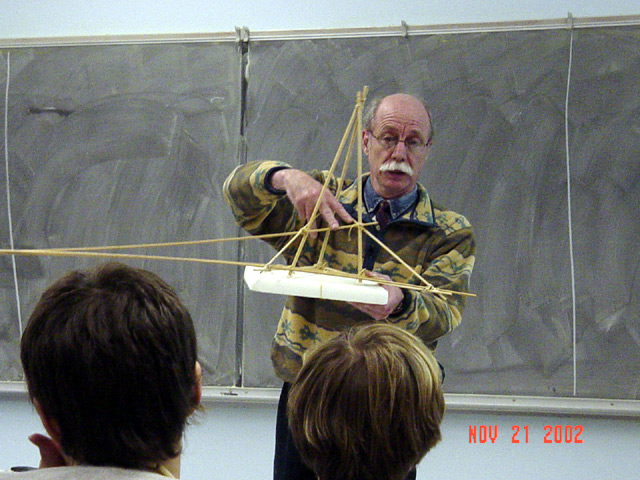
Member Highlight: Martin Flashman
Three questions with: Martin Flashman, Professor Emeritus of Mathematics, Cal Poly Humboldt
What did you enjoy about teaching geometry?
I taught geometry to two different audiences:
Math majors with some inclination to proceed to secondary teaching or a graduate program in mathematics.
Students taking mathematics to fulfill some general education requirements for a bachelor’s degree.
In different ways, what I enjoyed in teaching both these groups was seeing the positive energy and enjoyment when these students would see something deeper in the topic under discussion.
For the math major, it might be in seeing the power and generality of projective and hyperbolic geometries and their transformations both synthetic and algebraic connecting the axioms of Euclid to Descartes and Hilbert.
For the general education student, it might be in realizing the ability to use transformations to classify symmetries or projective geometry to understand perspective in art, or the freeing experience of beginning to comprehend the nature of dimension.
What was it like for you to teach future secondary teachers?
Teaching future secondary teachers was a challenge because some of them had only a minimal background and experience with geometry. Seeing them make progress in understanding the many complex interrelations between the manifold approaches to geometry and the rigorous axiomatic underpinnings made me hopeful that they had learned more in being able to explore geometry and mathematics further beyond this single course.
What are you most interested in learning/achieving through participating with the GeT: A Pencil community?
I am most interested in seeing that the SLO’s being articulated for the GeT courses are a rich resource for instructors of these courses to draw upon as they design their own courses to fit into their programs to educate future secondary teachers.
Did you get promoted? Win a grant? Have a baby? Buy a house? We would love to feature your news, whether professional or personal! Email us at GRIP@umich.edu.

Upcoming Seminars
Bulgarian Experience in Teaching of School Geometry for Future Mathematics Teachers
Presenter : Kiril Bankov
Date : Friday, November 10th, 2023

To submit a paper to be highlighted in a future newsletter, please fill out this form.
GeT Support
Sponsored by NSF DUE-1725837. All opinions are those of the authors and do not necessarily represent the views of the National Science Foundation or the University of Michigan.
Patricio Herbst, PI
Amanda Milewski, Co-PI
Get Support is housed in the GRIP Lab at the University of Michigan
Inese Berzina Pitcher, Project Manager
